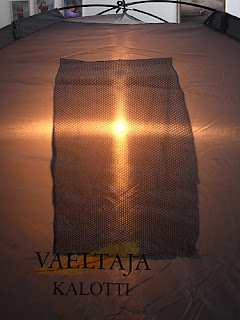We got to the hide nice and early, there was only the slightest hint of light on the horizon. We unpacked our gear and crawled into the hide. Once inside, we put on plenty of warm clothing and started setting up our cameras in anticipation of the morning and hopefully arriving grouses. That is when things took bad turn on us. Eventhough Nea had enough clothing on to cause the average eskimo to die of heat exhaustion, the cold of the night got thru. We tried to tough it out for awhile and tried to come up with some way of keeping Nea warm, but it was hopeless. In the end we had no choice, but to pack our gear and head back to the car and the warmth of home.
Skiing back to the car warmed Nea up enough that she felt good enough to stop and take a few pictures along the way:



 These few quick snapshots saved the whole trip, the sadness of not being able to take pictures of grouses was forgotten. As we skied along, we did hear grouse calls in the distance, but did not ponder on them for long, we decided to talk about the tracks on the snow, the beautiful colors of the sunrise and what we would be photographing when the weather becomes warmer. Nea did ask me if the birds would flee if we skied to where the sounds were coming from.
These few quick snapshots saved the whole trip, the sadness of not being able to take pictures of grouses was forgotten. As we skied along, we did hear grouse calls in the distance, but did not ponder on them for long, we decided to talk about the tracks on the snow, the beautiful colors of the sunrise and what we would be photographing when the weather becomes warmer. Nea did ask me if the birds would flee if we skied to where the sounds were coming from.At the end of our outing, Nea and I agreed that we could go skiing and taking pictures, but sitting in the hide with freezing temperatures is a bit too rough for Nea at the moment. Now we are just waiting for spring to really arrive and the snow to melt so that we could go for a walk-about to see what we can find for us to see and photograph.


































